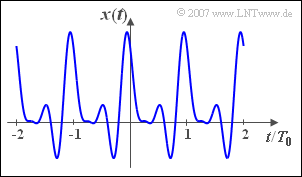Difference between revisions of "Aufgaben:Exercise 2.6Z: Magnitude and Phase"
From LNTwww
| Line 41: | Line 41: | ||
$D_0\ = \ $ { 1 3% } $\text{V}$ | $D_0\ = \ $ { 1 3% } $\text{V}$ | ||
$C_0\ = \ $ { 1 3% } $\text{V}$ | $C_0\ = \ $ { 1 3% } $\text{V}$ | ||
| − | $\varphi_0\ = \ $ { 0. } $\text{ | + | $\varphi_0\ = \ $ { 0. } $\text{degrees}$ |
| Line 56: | Line 56: | ||
{What are the values of the coefficients $\varphi_1$, $C_1$ und $D_1$? | {What are the values of the coefficients $\varphi_1$, $C_1$ und $D_1$? | ||
|type="{}"} | |type="{}"} | ||
| − | $\varphi_1\ = \ $ { 0. } $\text{ | + | $\varphi_1\ = \ $ { 0. } $\text{degrees}$ |
$C_1\ = \ $ { 2 3% } $\text{V}$ | $C_1\ = \ $ { 2 3% } $\text{V}$ | ||
$\text{Re}[D_1]\ = \ $ { 1 3% } $\text{V}$ | $\text{Re}[D_1]\ = \ $ { 1 3% } $\text{V}$ | ||
| Line 64: | Line 64: | ||
{What are the values of the coefficients $\varphi_2$, $C_2$ und $D_2$? | {What are the values of the coefficients $\varphi_2$, $C_2$ und $D_2$? | ||
|type="{}"} | |type="{}"} | ||
| − | $\varphi_2\ = \ $ { -26.6--26.5 } $\text{ | + | $\varphi_2\ = \ $ { -26.6--26.5 } $\text{degrees}$ |
$C_2\ = \ $ { 2.236 3% } $\text{V}$ | $C_2\ = \ $ { 2.236 3% } $\text{V}$ | ||
$\text{Re}[D_2]\ = \ $ { 1 3% } $\text{V}$ | $\text{Re}[D_2]\ = \ $ { 1 3% } $\text{V}$ | ||
| Line 73: | Line 73: | ||
{What are the values of the coefficients $\varphi_3$ und $C_3$? | {What are the values of the coefficients $\varphi_3$ und $C_3$? | ||
|type="{}"} | |type="{}"} | ||
| − | $\varphi_3\ = \ $ { -91--89 } $\text{ | + | $\varphi_3\ = \ $ { -91--89 } $\text{degrees}$ |
$C_3\ = \ $ { 1 3% } $\text{V}$ | $C_3\ = \ $ { 1 3% } $\text{V}$ | ||
Revision as of 22:30, 16 January 2021
The relationship between
- the real Fourier coefficients $A_n$ und $B_n$,
- the complex coefficients $D_n$, sowie
- the magnitude or phase coefficients $(C_n$, $\varphi_n)$.
For this we consider the periodic signal
- $$x(t)=1{\rm V+2V}\cdot\cos(\omega_0 t) +{\rm 2V}\cdot\cos(2\omega_0 t)- \ {\rm 1V}\cdot\sin(2\omega_0 t)-{\rm 1V}\cdot\sin(3\omega_0 t).$$
This signal is shown in the graph in the range from $–2T_0$ bis $+2T_0$ dargestellt.
Hints:
- This exercise belongs the the chapter Fourier Series.
- You can find a compact summary of the topic in the two learning videos
Questions
Solution
(1) Der Gleichsignalkoeffizient beträgt $A_0 = 1\,{\rm V}$.
- Gleichzeitig gilt $C_0 = D_0 = A_0 \hspace{0.1cm}\Rightarrow \hspace{0.1cm} C_0 \hspace{0.1cm}\underline{= 1\,{\rm V}}, \varphi_0 \hspace{0.1cm}\underline{= 0}$.
(2) Richtig sind die Antworten 1, 3, 4 und 6:
- Es gibt keine Anteile mit $\sin(\omega_0t)$ und $\cos(3\omega_0t)$.
- Daraus folgt direkt $B_1 = A_3 = 0$.
- Alle anderen hier aufgeführten Koeffizienten sind ungleich Null.
(3) Allgemein gilt:
- $$\varphi_n=\arctan\left({B_n}/{A_n}\right),\hspace{0.5cm}C_n=\sqrt{A_n^2+B_n^2},\hspace{0.5cm}D_n={1}/{2} \cdot (A_n-{\rm j}\cdot B_n).$$
- Wegen $B_1 = 0$ erhält man $\varphi_1 \hspace{0.1cm}\underline{= 0}, \ C_1 = A_1 \hspace{0.1cm}\underline{= 2 \,{\rm V}}$ und $D_1 = A_1/2 \hspace{0.1cm}\underline{= 1 \,{\rm V}}$.
(4) Mit $A_2 = 2\,{\rm V}$ und $B_2 = -1\,{\rm V}$ erhält man:
- $$\varphi_2=\arctan(-0.5)\hspace{0.15cm}\underline{=-26.56^{\circ}},\hspace{0.5cm}C_2=\sqrt{A_2^2+B_2^2}\hspace{0.15cm}\underline{=2.236 \; \rm V},$$
- $$D_2={1}/{2} \cdot (A_2-{\rm j}\cdot B_2)=1\;\rm V+{\rm j}\cdot 0.5\, {\rm V} \hspace{0.3cm}\Rightarrow \hspace{0.3cm}{\rm Re}[D_2]\hspace{0.15cm}\underline{ = 1 \,{\rm V}}, \hspace{0.2cm}{\rm Im}[D_2]\hspace{0.15cm}\underline{ = 0.5\, {\rm V}} .$$
(5) Es ist $\varphi_3 \hspace{0.15cm}\underline{=\hspace{0.1cm}-90^{\circ}}$ und $C_3 = |B_3| \hspace{0.15cm}\underline{ = 1 \,{\rm V}}$.
(6) Es gilt $D_3 = -{\rm j} · B_3/2 ={\rm j}· 0.5 \,{\rm V}$ und $D_\text{–3} = D_3^{\star} ={\rm j}· B_3/2 = {- {\rm j} · 0.5 \,{\rm V}}$
- $$\Rightarrow \hspace{0.3cm} \text{Re}[D_{-3}]\hspace{0.15cm}\underline{=0}, \hspace{0.5cm}\text{Im}[D_{-3}]\hspace{0.15cm}\underline{=\hspace{0.1cm}- 0.5 \,{\rm V}}.$$
